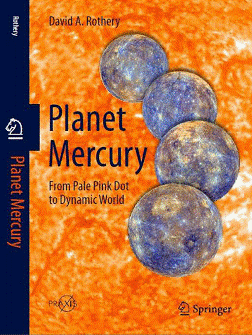 Messenger’s Mercury mission ended today, the day pf writing, with a bang and silence, according to the BBC. The mission was remarkably successful, despite widespread doubt that the probe would reach Mercury. Originally planned to include one year orbiting the planet, it was extended twice and lasted four years. It finished when Messenger crashed into the surface because its fuel ran out. The mission produced 270,000 images and 10 terabytes of data.
Messenger’s Mercury mission ended today, the day pf writing, with a bang and silence, according to the BBC. The mission was remarkably successful, despite widespread doubt that the probe would reach Mercury. Originally planned to include one year orbiting the planet, it was extended twice and lasted four years. It finished when Messenger crashed into the surface because its fuel ran out. The mission produced 270,000 images and 10 terabytes of data.
The book comprises seven, well illustrated, chapters: the first being a good summary of pre-space-age knowledge of the planet. The next three chapters describe, in turn, the probes and equipment for Mariner 10 (NASA, launched 1974), Messenger (NASA, 2004), and BepiColombo (ESA, scheduled 2016). Fairly detailed technical information is presented but, at 64 pages, might be thought to occupy too much of the book. Some will want even more detail, of course.
The remaining chapters give an extended outline of what was learnt from Mariner 10 and Messenger. Much relates to the differing terrains across Mercury’s surface – from craters to extensive plains (which cover 27% of the surface), with quasi-linear rises, etc. These major types of topographic feature are fundamental to any understanding of elemental and/or mineral distribution, etc, on which there is also a wide spread of information. Clear evidence exists, among other things, of crustal shortening.
After the surface which, naturally, is covered thoroughly, are chapters dealing with the planet’s interior – from mantle to inner core – its exosphere, and its somewhat strange magnetic field, which is off-centre vertically on the rotational axis. The occasional, small, information gems in the book are excellent. Thus, one might think that the sun’s proximity would prevent “water” from remaining near the planet’s surface. In fact, there is thought to be ice in deep craters near the north pole, never touched by sunlight because of the angle of incidence. A metre of ice here would take 1 billion years to sublime. If it were covered by 10cm lag deposits, the rate would slow a thousand-fold, to one millimetre per billion years.
The editing is disappointing at times, with confusing text and inexplicable variations in the diameter of the same crater. It might have been useful, beyond this, to include both a glossary and a map showing the principal features discussed. Notwithstanding these issues, this is a good book and a pleasure to own. It will live where it can be found easily.
PLANET MERCURY – FROM PALE PINK DOT TO DYNAMIC WORLD by David A Rothbery, 2015. Published by: Springer International Publishing Switzerland. ISBN: 978-3-319-12116-1. Hbk. 180pp. List Price €59.49. www.springer.com/series/4097